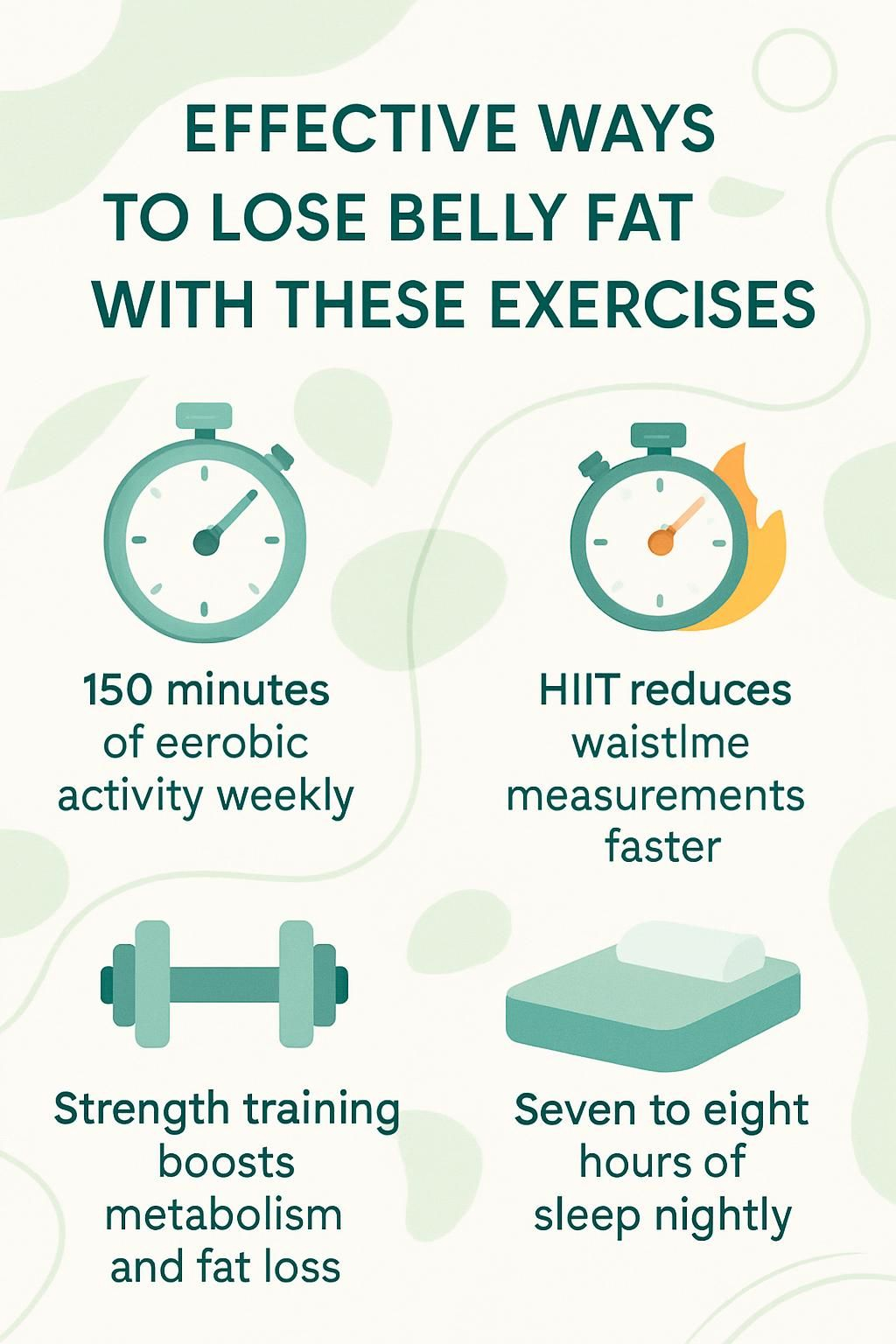Effective Ways To Lose Belly Fat Fast With These Exercises
Our Nutrition Assistant AI Suite will transform your body. You will lose fat, get toned, and build muscle. Gain confidence and optimal health.
If you want to lose belly fat and keep it off, you are in good company. Too much belly fat raises your risk of type 2 diabetes and heart disease. This guide gives you clear, safe ways to help you lose weight with exercise, including aerobic exercise and strength training.
Keep reading to find smart steps that trim your waistline and support long-term health.
Key Takeaways
- Do at least 150 minutes a week of aerobic exercise like brisk walking, running, cycling, or swimming to reduce total and visceral fat (Harvard Medical School, 2021).
- High-Intensity Interval Training, or HIIT, burns more calories in less time than steady cardio and can shrink your waist faster when practiced often (2018 research).
- Strength training builds muscle mass and boosts metabolism. Pairing weights with aerobic activity speeds abdominal fat loss in men and postmenopausal women.
- Sleep seven to eight hours per night. Good sleep balances hunger hormones. Poor sleep can raise appetite and belly fat.
- Choose fiber-rich foods and limit refined sugar. This pattern improves insulin resistance and lowers the risk of abdominal obesity.

Different Types of Belly Fat and Their Health Risks

Belly fat comes in two forms. Subcutaneous fat sits under your skin. Visceral fat lies deeper and surrounds your organs.
What Are Subcutaneous and Visceral Fat?
Subcutaneous fat is the layer you can pinch around your belly, thighs, or arms. Visceral fat wraps around your liver, intestines, and other organs in the abdomen.
Your body can use visceral fat for quick energy. Too much of it raises health risks. Higher visceral adipose tissue links to insulin resistance, chronic inflammation, and a greater chance of serious disease.
Tracking your waist can help you notice changes. As you lower inches, you tend to reduce deeper abdominal fat as well as the pinchable layer under the skin.
Diet and exercise lower total body fat. This approach helps reduce the most harmful type, visceral belly fat.
Why Is Excess Belly Fat Dangerous to Your Health?
Where fat sits matters. Visceral fat is more harmful than the layer under your skin. It surrounds major organs and releases fatty acids and chemicals called cytokines into your blood. These can drive inflammation and disturb normal function.
High levels of visceral fat raise the risk of heart disease, type 2 diabetes, high blood pressure, stroke, and some cancers. People with abdominal obesity are more likely to develop metabolic syndrome.
Even at a normal body mass index, extra visceral fat can strain your organs. A slight increase in waist size can affect cholesterol and blood pressure. Active living helps reverse these trends and improves health markers over time.
Why Is Exercise Important for Losing Belly Fat?
Exercise helps you lose belly fat by burning calories and lowering total body fat. It also targets visceral fat, which protects your heart and lowers your risk of type 2 diabetes.
Experts suggest at least 150 minutes per week of moderate aerobic exercise. Regular activity also protects muscle mass while you lose weight, which keeps your metabolism from slowing down.
Combining aerobic exercise with resistance training is one of the best ways to reach a healthy weight and cut abdominal fat.
Workouts also reduce stress hormones like cortisol, which can trigger belly fat storage. For lasting change, pair a balanced diet with consistent movement.
Effective Aerobic Exercises to Burn Belly Fat
Aerobic workouts raise your heart rate and help your body use stored energy. Pick activities you enjoy so you can stay consistent.
How Does Brisk Walking Help Reduce Belly Fat?
Brisk walking lifts your heart rate and burns calories, which helps reduce visceral fat. Doing at least 30 minutes a day, five days a week, can shrink the waist and support heart health.
In studies, people who walked briskly lost more abdominal fat than those who stayed inactive. Walking also eases stress and supports digestion, two factors tied to belly fat.
For more challenge, add hills or increase pace. If you want greater intensity, move toward short jogging intervals.
Is Running or Jogging Good for Belly Fat Loss?
Running and jogging burn more calories per minute than many other activities. This helps reduce excess fat around your midsection, including deep visceral fat.
Thirty minutes of moderate to vigorous running at least five days a week can help overweight or obese adults reduce abdominal fat. These workouts also build skeletal muscle, which keeps your metabolism active after you stop moving.
Pair runs with small nutrition changes. For example, swap sugary drinks for water and jog most days. Many people see a smaller waist within two months when they stay consistent.
What Are the Benefits of Swimming for Fat Burning?
Swimming works your whole body with less impact on joints. It burns many calories and builds lean muscle, which supports a stronger metabolism.
At a moderate pace, a 155-pound person may burn about 223 calories in 30 minutes. Water provides natural resistance, so each stroke trains your core and improves heart health. This is a good choice if running hurts your knees or hips.
How Does Cycling Aid in Losing Belly Fat?
Cycling raises your heart rate, builds leg and core strength, and helps you burn calories. Regular rides, 30 minutes most days, support weight management and reduce waist size.
Many people find cycling easier on the joints than running. If you enjoy riding, mix steady efforts with short, faster bursts for added fat loss.
High-Intensity Interval Training (HIIT) for Fat Loss
HIIT uses short, hard efforts followed by rest. It is time-efficient and supports quick drops in waist measurement.
What Are the Benefits of HIIT for Losing Belly Fat?
HIIT often burns more calories in less time than steady cardio. It can raise your metabolic rate for hours after you finish, so you keep burning energy while you recover.
Research shows HIIT reduces visceral fat, which lowers the risk of cardiovascular disease. In a 2018 study, people who followed regular HIIT lowered their waistline faster than those doing only moderate aerobic work.
If long sessions are hard to schedule, try 15 to 20 minutes of HIIT a few days a week. You will train your heart and build lean muscle at the same time.
What Is a Simple HIIT Routine for Beginners?
Start with a short routine and focus on form. As fitness improves, add more rounds.
- Warm up for 3 to 5 minutes with brisk walking or light jogging.
- Do jumping jacks at a fast pace for 30 seconds.
- Rest for 30 seconds.
- Do mountain climbers for 30 seconds at a steady pace.
- Rest for 30 seconds with deep breathing.
- Do high knees for 30 seconds, lifting each knee toward your chest.
- Rest for 30 seconds and sip water if needed.
- Do squat jumps for 30 seconds, landing softly.
- Cool down with slow walking and gentle stretching for several minutes.
Begin with three to four cycles. Track how many rounds you complete and add one round when the workout feels manageable.
Strength Training Exercises to Reduce Belly Fat
Strength training builds muscle mass, which raises daily calorie burn. You can use free weights, machines, or your body weight.
How Does Weight Lifting Help Burn Belly Fat?
Weight lifting increases muscle, and muscle uses more energy than fat, even when you rest. As you age, you tend to lose muscle. Lifting helps protect it and supports a healthy metabolism.
Studies show strength training reduces both visceral and subcutaneous fat. Combining weights with aerobic exercise can trim your waist faster than doing either one alone.
What Are Effective Bodyweight Exercises for Belly Fat?
Bodyweight moves can raise your heart rate and train your core without equipment.
- Planks strengthen the abs, lower back, and shoulders. Hold 20 to 60 seconds per set.
- Push-ups train the chest, arms, and core. Aim for 10 to 15 repetitions per set.
- Mountain climbers mix cardio with core work. Go for 30 seconds per set.
- Bicycle crunches target upper and lower abs and the obliques. Do 15 to 20 controlled reps.
- Leg raises focus on the lower abs. Perform 12 to 18 repetitions per set.
- Russian twists build rotational core strength. Complete about 20 total twists.
- Sit-ups build strength along the front of the abdomen. Do three sets of 12 to 20 with good form.
These moves increase calorie burn and support a healthier body composition. The Centers for Disease Control and Prevention encourages two or more strength sessions per week.
Core-Strengthening Exercises to Tone Your Abs
A strong core supports your spine, improves posture, and helps protect your organs. It also helps your workouts feel easier and safer.
What Are Different Plank Variations to Try?
Planks train your entire midsection. Changing the version keeps training fresh and targets more muscles.
- Standard Forearm Plank: Place elbows under shoulders with forearms on the floor. Keep a straight line from head to heels and brace your abs and glutes. Hold 20 to 30 seconds while breathing steadily.
- Side Plank: Lie on your side with legs stacked. Press through your forearm and lift your hips. Keep your top hand on your hip or reach it up. This hits the obliques along your sides.
- Plank with Leg Lift: From a forearm plank, raise one straight leg for a brief hold, then switch. This adds work for the glutes and lower back.
- Plank to Push-Up (High-Low Plank): Move from a forearm plank to a high plank on your hands, one arm at a time, then return. This challenges your core and upper body.
- Reverse Plank: Sit with legs extended. Place hands behind you, fingers forward, then lift hips into a straight line from shoulders to feet. This trains the abs, back, glutes, and arms.
- Walking Plank: In a high plank, step your right hand and foot to the side, then your left. Take a few steps each way to increase intensity.
- Hip Dips: In a forearm plank, rotate your hips side to side for 10 to 15 repetitions. This strengthens the obliques and tightens your waist.
How Do Crunches and Sit-ups Help Your Core?
Crunches lift your upper back off the floor to train the rectus abdominis, the front sheet of your abs. Sit-ups use more muscles, including the hip flexors and lower back, which improves stability.
Regular core training improves posture and balance. Start with 10 to 15 reps and increase as form improves. Pair core moves with aerobic exercise for better fat loss around the midsection.
How to Do Russian Twists for Core Strength?
Russian twists build rotational strength and sharpen your waistline. You can use a dumbbell, medicine ball, or no weight at all.
- Sit with knees bent and feet flat. Hold a weight at chest level if using one.
- Lean back slightly to engage your core. Keep your spine long.
- Lift your feet for more challenge or keep them down for support.
- Twist your torso to the right and bring the weight beside your hip.
- Twist to the left with controlled motion while breathing steadily.
- Complete 10 to 20 repetitions per side.
- Do two to three sets to strengthen your core.
Next, add a few targeted moves like mountain climbers to round out your routine.
Targeted Abdominal Workouts to Sculpt Your Belly
Targeted ab training builds muscle under the skin and supports a tighter waist. It works best alongside fat-burning cardio.
How to Perform Mountain Climbers Correctly?
Mountain climbers are a fast, core-heavy move. They also raise your heart rate to help you burn more calories.
- Start in a high plank with hands under shoulders and a straight body line.
- Brace your stomach to protect your lower back.
- Drive one knee toward your chest while the other leg stays extended.
- Switch legs quickly, as if running in place.
- Breathe evenly and avoid holding your breath.
- Keep hips level and resist sagging through the lower back.
- Work for 30 to 60 seconds per set and aim for three sets.
- Raise intensity by moving faster or using light ankle weights.
- Keep rests short to maintain a higher heart rate.
This move targets deep core muscles and can help reduce visceral fat when combined with training and smart eating.
What Are Bicycle Crunches and Their Benefits?
Bicycle crunches train upper and lower abs and the obliques at the same time. Lie on your back, lift your legs, and rotate so your opposite elbow meets your knee as it comes in.
Research shows bicycle crunches create strong muscle activation in the ab region. They are simple, need no equipment, and can be added after a run or walk.
How Do Leg Raises Help Your Abs?
Leg raises focus on the lower abs. Lie flat, keep legs straight, and lift them together without using momentum. Lower slowly to increase the challenge.
This move also trains the hip flexors, which support stable movement. Use it with cardio and smart nutrition choices, like cutting added sugar from sweetened drinks, for better fat loss.
Lifestyle Changes That Support Belly Fat Loss
Small daily habits matter. Sleep, stress control, and hydration help your plan work better.
Why Is Quality Sleep Important for Fat Loss?
Good sleep balances hunger hormones. Short sleep raises ghrelin, which increases hunger, and lowers leptin, which helps you feel full. People who sleep less than seven hours tend to eat more convenience foods that are high in sugar and fat.
Sleep also supports recovery after workouts and helps you build muscle mass. Many people see better scale results when they get seven to eight hours a night.
How Can Managing Stress Help Reduce Belly Fat?
Stress raises cortisol, a hormone linked to belly fat storage. High cortisol can drive cravings and overeating.
Use simple tools like deep breathing, short walks, or guided meditation. People who practice relaxation techniques often reduce subcutaneous abdominal fat over time [1]. A steady routine that includes exercise, balanced meals, rest, and stress care supports healthy weight loss without supplements.
[1] Harvard Health Publishing, 2018: “The truth about belly fat.”
How Does Staying Hydrated Affect Fat Loss?
Water helps your metabolism work well and may reduce hunger. Drinking about 17 ounces can raise metabolic rate for almost an hour in some studies.
Hydration also aids digestion and reduces bloating, helping your waist look slimmer. If you drink alcohol, water becomes even more important since alcohol dehydrates you and slows fat burning. Aim for at least eight cups a day, and more if you sweat heavily.
Dietary Tips to Enhance Your Exercise Results
Smart food choices support training and make each workout count. Focus on steady habits rather than strict rules.
What Foods Should You Eat for Belly Fat Loss?
Choose foods that keep you full and support your heart and gut.
- Lean proteins like chicken, fish, tofu, and eggs to support muscle repair and fullness.
- High-fiber foods like oats, beans, lentils, broccoli, berries, and apples for digestion and better blood sugar control.
- Whole grains like brown rice, quinoa, barley, and whole wheat bread for stable energy.
- Healthy fats in moderation from avocados, olive oil, nuts, and seeds.
- Non-starchy vegetables such as leafy greens, carrots, peppers, tomatoes, and cucumbers for vitamins with few calories.
- Limit added sugars and highly processed snacks. These often raise abdominal fat and harm weight control.
- Drink water instead of soda or juice to support metabolism and trim extra calories.
Adding these foods makes exercise pay off. You will find it easier to stay full, protect muscle, and manage cravings.
Why Avoid Sugary and Processed Foods?
Sugary drinks, pastries, white bread, and packaged snacks provide energy without nutrients. They spike blood sugar and can increase visceral fat. People who consume more added sugar have a higher risk of abdominal obesity, according to studies in nutrition journals.
These foods also raise insulin resistance, which makes fat loss harder. Replacing soda with water and choosing whole foods can lift energy within a week and help reduce belly fat.
How Does Eating Fiber-Rich Foods Help?
Soluble fiber slows stomach emptying, which helps you feel full with fewer calories. Foods like beans, oats, fruit, and vegetables are strong sources.
Fiber feeds helpful gut bacteria. They produce short-chain fatty acids that may reduce fat storage around the waist. Adults who increase soluble fiber often gain less visceral fat over time. Many people notice fewer cravings and less bloating within weeks.
How to Track Your Belly Fat Loss Progress
Tracking keeps you honest and motivated. Simple measurements and photos show progress that the scale can miss.
How to Monitor Body Measurements Effectively?
Use a soft tape measure for your waist, hips, and belly. Measure at the same time each week. Stand tall, relax your stomach, and wrap the tape snug, not tight, around the widest part of your belly.
Log the numbers in a journal or app. Take photos monthly in the same lighting and pose. These habits make small wins visible.
What Are the Best Fitness Apps or Journals to Use?
Apps can simplify logging workouts, sleep, and meals. Some connect to a watch or tracker so your steps and heart rate are recorded automatically. Paper works too if you like writing things down.
Summary Table:
| Option | Features |
|---|---|
| MyFitnessPal | Food logging and calorie tracking |
| Fitbit | Activity and sleep tracking |
| Lose It! | Detailed nutrition insights |
| Paper Journal | Custom notes and flexible tracking |
Choose the method you will use daily. Consistency matters more than the tool you pick.
Common Mistakes to Avoid When Losing Belly Fat
A few common errors can slow your progress. Avoid them to protect your results and your motivation.
Why Spot Reduction Exercises Alone Don’t Work?
Doing endless crunches will not melt fat from only your belly. Fat loss happens across your entire body through a process called lipolysis. Research shows targeted exercise does not pull more fat from the working area. For example, a 2011 study found no extra loss of abdominal fat in people who did only core workouts compared to controls.
Create a calorie deficit with aerobic exercise and strength training. This approach raises your metabolism and reduces total body fat, including the fat around your belly.
Why Should You Not Skip Rest Days?
Your muscles need time to repair after hard work. Training without recovery can lead to fatigue, injury, and higher cortisol. That mix can stall progress and even add fat.
Plan rest days and easy sessions. Recovery helps you train harder on workout days and supports steady fat loss.
How Important Is Consistency in Losing Belly Fat?
Consistency turns small actions into big change. Regular exercise and balanced meals help you burn more calories over time and protect muscle mass.
Set a schedule you can keep. Many people notice clear changes by week eight. Daily logging, even of short walks, can keep your momentum strong.
Frequently Asked Questions About Belly Fat Loss
These quick answers can guide your plan and set realistic expectations.
How Long Will It Take to See Belly Fat Loss Results?
Most people see visible changes in 4 to 8 weeks. Results depend on exercise frequency, food choices, sleep, and stress. A safe target is 1 to 2 pounds per week through a calorie deficit, which combines activity and nutrition.
Measure your waist every two weeks. Small, steady drops show you are on track.
Does Age Affect Your Ability to Lose Belly Fat?
Age does matter. Metabolism slows and muscle mass often decreases. Hormone shifts, such as lower estrogen or testosterone, can increase belly fat, including after menopause for many women.
You can still make strong progress. Use aerobic exercise, strength training, protein-rich meals, and quality sleep to support fat loss at any age. Harvard Health Publishing notes belly fat can rise after menopause, so active habits are even more important.
Conclusion
Regular movement and simple daily habits help you lose belly fat and protect your health. Use aerobic exercise like walking, running, cycling, or swimming to burn calories. Add strength training and core work to build muscle and tighten your midsection.
Pair training with fiber-rich foods, lean protein, and less added sugar. Track your measurements, use a journal or app, and aim for at least 150 minutes of moderate activity each week. If you have a medical condition or take medication, talk with a healthcare professional before changing your routine. Stay patient and consistent. Progress adds up, one workout and one meal at a time.
FAQs
1. What are the most effective exercises to lose belly fat fast?
Aerobic activities such as brisk walking, cycling, and swimming help burn calories and reduce abdominal fat. Strength training with compound movements like squats or push-ups also supports muscle growth and boosts metabolism. Research from Harvard Medical School shows that combining aerobic exercise with resistance training leads to greater reductions in visceral fat compared to either method alone.
2. How often should I do these exercises for best results?
Aim for at least 150 minutes of moderate-intensity aerobic activity each week along with two days of strength training targeting major muscle groups. The Centers for Disease Control and Prevention recommends this schedule for adults seeking weight loss benefits.
3. Can targeted ab workouts alone remove belly fat?
Targeted abdominal routines such as crunches or planks strengthen core muscles but do not directly eliminate belly fat. Studies published in the Journal of Strength and Conditioning Research confirm that spot reduction is a myth; overall body fat decreases through consistent full-body exercise paired with healthy eating habits.
4. Have people seen real results using these methods?
Many individuals report noticeable changes after following structured workout plans focused on both cardio and resistance exercises while maintaining balanced nutrition. For example, after three months on a combined program, I experienced improved waist measurements alongside increased energy levels, which aligns with findings from clinical trials showing similar outcomes among participants.
Summary: Combining regular aerobic activity with strength training offers an evidence-based approach to reducing belly fat quickly when paired with proper nutrition and consistency over time.







